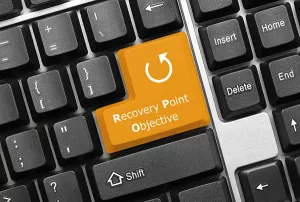When it comes to data backup and disaster recovery planning your recovery point objective (RPO) is a critical tool. Put simply, your RPO is the metric you set for the amount of data your organization can tolerate losing in a data disaster. Your RPO helps you determine how often you need to back up your data, and the infrastructure you need to have in place to support your backup plan.
It's important to note that, despite its title, RPO is less about the actual execution of recovery and more about establishing the framework so that when you do have to recover from a data loss, you'll be able to get all of the data you need back up and available. RPO isn't a tool for measuring or reducing downtime. That's where your recovery point objective (RTO) comes into play.
So let’s take a deeper look into determining your RPO.  Even if your systems are protected by a high availability system, you may lose some data when a disaster strikes. The question you have to ask is, how much data can my organization afford to lose?
Unfortunately, that’s a complicated question. Most likely your gut reaction is, “I don’t want to lose any of my data. I need all of it.” There are options for meeting that requirement, including StorageCraft backup and disaster recovery solutions, but there are a number of factors you need to consider—including cost—when determining your RPO.
Every backup you take on every system in your environment takes up space, and if you’re taking backups every 15 minutes it can really add up. That’s not to mention the bandwidth each backup takes across your network. Enter RPO. Calculating your RPO helps you set up your backup solution so that it fits both your data and your budget. By realistically assessing the amount of data you can afford to lose, you put yourself in a position to balance those data needs with your current infrastructure and identify areas where you may need to make updates.
Say you determine that you can really only afford to lose an hour’s worth of data. It's relatively simple to do the math and figure out how many servers and the amount of bandwidth you need to make that happen.
Keep in mind that different systems will have different RPOs. Critical systems, like those in development or accounting (or your CEO’s laptop), may demand more rigorous RPOs because a data loss in those areas could create serious problems for the company.
Even if your systems are protected by a high availability system, you may lose some data when a disaster strikes. The question you have to ask is, how much data can my organization afford to lose?
Unfortunately, that’s a complicated question. Most likely your gut reaction is, “I don’t want to lose any of my data. I need all of it.” There are options for meeting that requirement, including StorageCraft backup and disaster recovery solutions, but there are a number of factors you need to consider—including cost—when determining your RPO.
Every backup you take on every system in your environment takes up space, and if you’re taking backups every 15 minutes it can really add up. That’s not to mention the bandwidth each backup takes across your network. Enter RPO. Calculating your RPO helps you set up your backup solution so that it fits both your data and your budget. By realistically assessing the amount of data you can afford to lose, you put yourself in a position to balance those data needs with your current infrastructure and identify areas where you may need to make updates.
Say you determine that you can really only afford to lose an hour’s worth of data. It's relatively simple to do the math and figure out how many servers and the amount of bandwidth you need to make that happen.
Keep in mind that different systems will have different RPOs. Critical systems, like those in development or accounting (or your CEO’s laptop), may demand more rigorous RPOs because a data loss in those areas could create serious problems for the company.
Thinking Through Your RPO

How Much Data Can You Lose?
So what do we mean by how much data you can “afford to lose”? The answer usually varies. You and your team are the only ones who understand the value of your data, so when you’re determining your RPOs ask yourselves “what will happen after we lose specific data, including applications, structured, and unstructured data?” Will we need to recover all of it or is some of that data more or less expendable? What if it’s not expendable? Then set your RPO and corresponding backup schedule accordingly. Ultimately, determining an RPO for each of your systems is an essential part of your disaster recovery plan. Being prepared for a disaster is really all about understanding and adapting your IT environment to support your organization's objectives. RPO is one great tool to help you do just that.You May Also Like
- Backup and Disaster Recovery Business Continuity Cybersecurity Data Protection Data Resilience Ransomware
How Ransomware Works and What Your Company Can Do About It Today
April 18th, 2024 - Backup and Disaster Recovery Business Continuity Data Resilience
How to Build Business Resilience: A Comprehensive Guide for Today’s Enterprises
April 16th, 2024 - Backup and Disaster Recovery Data Storage
Primary Storage vs Secondary Storage: What's the Difference?
April 9th, 2024